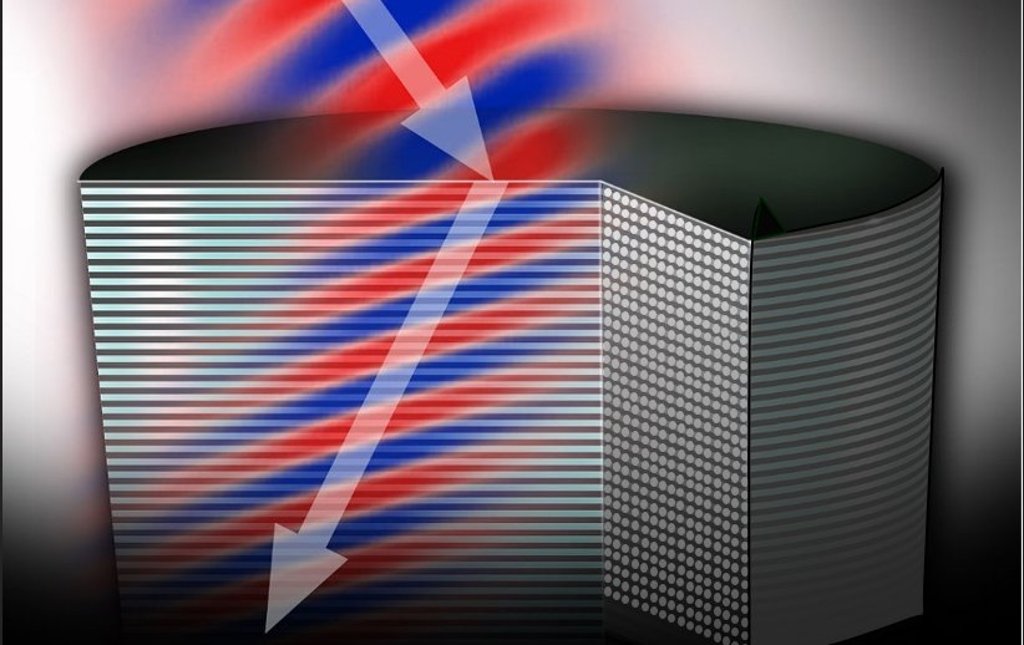Ceramic Resonators Open Metamaterial Doors

To most people, ceramics means pottery—glazed and fired clay fashioned into mugs or bowls. But ceramics have industrial applications too. The most important product of the ceramics industry is ceramic capacitors, which store electromagnetic energy. Another is ceramic resonators, which produce oscillations or back-and-forth movements.
Using small ceramic resonators three millimeters in diameter, Michigan Technological University researcher Elena Semouchkina has found a way to bend electromagnetic waves or light rays in dramatically different directions, enabling novel applications.
An associate professor of electrical and computer engineering at Michigan Tech, Semouchkina uses arrays of ceramic resonators to form metamaterials with a negative refractive index. This unusual property—which metamaterials can display and natural materials cannot—causes electromagnetic waves or light rays to behave in a very different way than natural materials do. Her ceramic resonator arrays have important applications in communications, such as miniaturized microwave antennas already developed and described in Semouchkina’s latest journal article
A paper describing her National Science Foundation-funded work was named one of the best papers presented at the Ceramic Interconnect and Ceramic Microsystems Technologies 2012 Conference in Erfurt, Germany. It is an invited paper in the latest issue of the International Journal of Microelectronics and Electronic Packaging, published by the International Microelectrics and Packaging Society.
“In our work we proposed to use small ceramic resonators as artificial ‘atoms’ of metamaterials,” Semouchkina explains. She ordered customized ceramic resonators from a European company.
Semouchkina uses metamaterials, which are artificial materials that have properties not found in nature. Metamaterials, which use small resonators instead of natural atoms or molecules, straddle the boundary between materials science and electrical engineering. Metamaterials were named one of the top three physics discoveries of the decade by the American Physical Society.
In fact, in July an open-source online organization called InTech notified Semouchkina that a chapter she had written in a book titled Metamaterials had been accessed online more than 500 times during the month after its publication, mostly by scientists and students from the US, China, Canada, India and Cuba. “We congratulate you once again on your success,” wrote a spokesperson for InTech’s Author Stats.
Conventionally, metamaterials have been made from split metal rings and cut wires. Semouchkina’s approach is different. She designs metamaterials that are dielectric—meaning that they do not conduct electricity— from glass or ceramics depending on the operational frequency.
“One of the most exciting applications of all-dielectric metamaterials is the potential to develop devices to provide invisibility,” the scientist says.
Two years ago, she designed a system for cloaking very small objects using resonators of a special kind of glass to refract light waves in the infrared range. Using magnetic resonance, her glass resonators captured infrared light waves and routed them around objects, rendering those objects invisible.
Her glass resonators were designed for cloaking objects from infrared waves, which have a shorter wavelength than microwaves. From infrared, she moved on to microwaves, which are longer and have a lower frequency than infrared waves.
Using arrays of identical ceramic resonators, Semouchkina took her experiments into Michigan Tech’s anechoic chamber, a cave-like room lined with highly absorbent charcoal-gray foam cones, located in Semouchkina’s microwave characterization lab in the Electrical Energy Resources Center. There, antennas transmit and receive microwaves, which are much longer than infrared light, up to several centimeters long.
Semouchkina was able to cloak metal cylinders two to three inches in diameter and three to four inches high. And she has no intention of stopping there. She plans to develop several new approaches to cloaking that will be easier to implement and useful for practical applications.
Michigan Technological University is an R1 public research university founded in 1885 in Houghton, and is home to nearly 7,500 students from more than 60 countries around the world. Consistently ranked among the best universities in the country for return on investment, Michigan's flagship technological university offers more than 120 undergraduate and graduate degree programs in science and technology, engineering, computing, forestry, business, health professions, humanities, mathematics, social sciences, and the arts. The rural campus is situated just miles from Lake Superior in Michigan's Upper Peninsula, offering year-round opportunities for outdoor adventure.




Comments